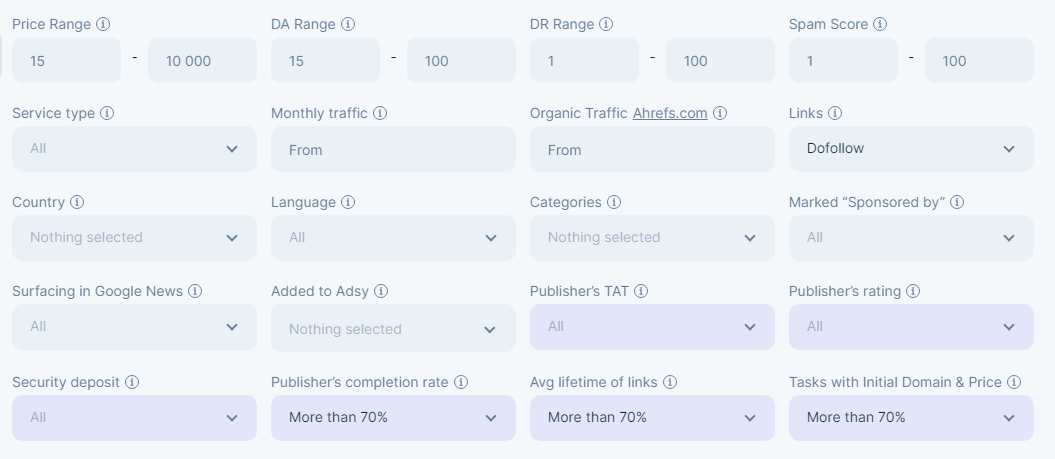Looking to grow your law firm’s online presence? Check out our latest blog post on law firm content marketing strategies specifically tailored for U.S. attorneys. Learn how creating valuable and informative content can attract new clients and establish your legal practice as an industry thought leader.
Do you know how many law firms are in the United States? Around 450 thousand.
How about individual law attorneys? Well, the number is much higher: over 1.3 million.
The US has the highest number of lawyers per capita in the world. If you’re a law firm or individual attorney, you have a serious competition to contend with.
Want to Grow Your Real Estate Business? Download the Complete Grant & Funding eBook for instant access to grants, guides, and more. 80+ Grant and Scholarship Opportunities (FG, State-by-State, General & Underrepresented Groups Scholarships, Plus Grant Writing Checklist). 900+ Copies Sold Already. Get Your Copy Now
If you have an online presence, congratulations! You’re ahead of many others who only exist offline.
But that doesn’t make the competition any lighter.
You must have a plan to fend off the online competition, which, in many ways, is more fierce.
An ideal way to start is by implementing law firm content marketing strategies. Thankfully we have put together some of these strategies to help you grow your legal practice in the United States.
So, let’s get started.
You Might Also Like: Business Growth Strategies: Top 10 Ways to Grow Your Business this Year
How Content Marketing Can Help U.S. Law Firms
Content marketing simply involves creating what will Attract, Engage, and Retain your target audience. It could be anything, including articles, infographics, videos, and podcasts.
The goal is to consistently put out content your audience finds valuable. That way, they will see your law firm as an industry thought leader, one they can trust and rely upon should they require any legal service.
It works! And the stats are there to prove it.
About 91% of professional marketers confirm that content marketing helped them achieve extreme success.
And research shows that 62% of customers rely on content to influence their purchase decisions.
Also, content marketing brings more leads (about three times more) than traditional outbound marketing. The mind-blowing part is that it costs 62% less.
Stats don’t lie!
But you won’t have these successes with non-uniform approaches. You need concrete law firm content marketing strategies that apply to the US legal landscape.
Let’s find out just how you can create those strategies.
Developing Your U.S. Law Firm Content Marketing Strategy
Follow these tips to create effective law firm content marketing strategies.
Law Firm Content Strategy 1: Research The Right Keywords With Marketing Miner
Punching keys on your keyboard is the simplest way to start content marketing.
Form words. Turn words into sentences and sentences into paragraphs. Finally, you get an article. Repeat.
You can then publish the articles you create on your law firm’s website for customers to read.
The question is, what will you write about? That’s where keywords come in.
Only a few customers will visit your website directly. Most will likely search keywords on Google and other search engines.
These are the keywords to include in your articles. And you can find them using Marketing Miner, a keyword research tool for data-driven marketers, and it has a free plan.

With it, you can uncover what US law customers search for across search engines. Then, select the right ones by analyzing the search volume, trends, search visibility, and content gap.
It’s best to target keywords with relatively low search volumes. Such keywords have no competition, which means you can easily rank for them on SERPs, getting instant engagements.
Law Firm Content Strategy 2: Optimize Your Content With SurferSEO To Rank On Google
Your content won’t magically rank on search engines.
Of course, you’d need to optimize it to rank highly in Google. And that’s where search engine optimization (SEO) comes in. Pulling this off is not as easy as it sounds, but online tools like SurferSEO make it effortless.
It features keyword research and site audit tools and a content editor that can help you quickly rank on Google. SurferSEO also ensures you insert the right keywords and in the right density, preventing keyword stuffing.
Additionally, the SurferSEO Content Editor makes your content clean, authentic, and well-structured, which is what you need to rank on Google.
Law Firm Content Strategy 3: Find Guest Posts Opportunities Using Adsy
Guest posting is one of the most straightforward ways to earn backlinks, which are one of Google’s most important search ranking signals.
Some relevant blogs in the law niche may be willing to accept your guest posts. And you can quickly find them using Adsy. The platform houses over 50 thousand publishers willing to accept your guest posts for a little fee.
When you sign up, log in as a buyer, then use the search filter to find relevant blogs and publishers with high DA ratings—at least 40 is ideal. Also, select only publishers from the United States. It makes your backlinks more relevant.

Use the guest posts to build quality links to the content you wish to rank. We recommend writing your guest posts or at least choosing the topics to inject SEO entities into your backlinks to make them more effective.
This article by Israel Guadette can guide you on how to build links the right way.
Law Firm Content Strategy 4: Build Engagement With Social Media
Social media benefits any marketing strategy, not just content.
When you share your content on social media, it could reach a potential 300 million people.
That’s the number of social media users in the United States. And that’s only around 31 million less than the country’s population.
The more social media users engage with your content, the more following you get, and the more your business grows.
But it can be overwhelming to manage accounts across many social media platforms: Facebook, Twitter, LinkedIn, Instagram, and others.
Nevertheless, Sendible can help. Here’s what you can do with it:
- Manage all your social media accounts from a central platform.
- Schedule posts at anytime
- Quickly engage with customers’ comments and likes.
Law Firm Content Strategy 5. Reach More People With Repurposed Content
Content repurposing helps you maximize the potential of a particular content.
Take, for instance, you create an article for your law firm’s website’s blog. You can repurpose the content into an infographic, video, or podcast.
That way, you can reach more people on social media, YouTube, and audio streaming platforms like Apple Music and Spotify.
Video and podcasts are the most rewarding when it comes to content repurposing. And leveraging them doesn’t have to be complicated.
For videos, you should use Lumen5.
It’s an online video maker that lets you create engaging videos by simply copying and pasting your blog posts. You can directly paste the blog post URL.
For podcasts, you should use Play.ht.
It works like magic. The tool can quickly convert your blog posts into podcasts in any language or accent in the world, eliminating the stress of creating podcasts.
Law Firm Content Strategy 6: Convert Blog Traffic to Leads With Convert Cart
You can have a million website visitors flock to view your content and still not record any customers.
Why? Because you have no strategy in place to convert those blog traffic to leads. However, with a tool like Convert Cart. Over 25,000 businesses in the United States and across the world use this tool to automate and boost their lead generation.
To begin, create a lead form with the tool and embed it as an inframe in your high-traffic blog posts. As visitors read your content, the form draws them to engage more. The key to winning their attention is having a killer welcome message.
Once a visitor engages with the lead bot, they’re no longer a random reader but a lead. And with their details, you can further market your legal services to them.
Content Marketing For Law Firms: What Next?
With your law firm’s content marketing strategies in motion, you may think the job is done.
But you’ll be wrong.
For content to be valuable and remain valuable, it must be recent. In other words, you must regularly update your content if you want them to market.
So, content marketing is more or less a persistent process.
Constantly monitor news in the law industry, customer feedback, and other valuable information. Then, use them to create new content or update existing ones.
Recommended For You: Free Business Templates to Streamline Your Workflow this New Year
Hand-Picked For You:
- FAQs: How to Start a Business In 2023
- FAQs: How to Grow Your Business In 2023
- FAQs: How to Fund Your Business In 2023
- Top Small Business Challenges and How to Navigate Them
- How to Rank On the Google First Page
- Backlink SEO Strategy: How to Build Quality External Links
- Small Business Leads Generation Strategies: How to Scale Your LeadsIn 2023
- How We Made Six Figures In 21 Days Just Sending Emails
Legal Practice Content Marketing FAQs
1. What is content marketing for law firms?
Content marketing for law firms involves creating valuable law-related content to attract, engage, and retain customers. It can be as simple as making a blog article that customers will always find helpful.
2. What are the top content marketing tools for law firms?
The top marketing tools for law firms are Marketing Miner, SurferSEO, AdSpy, social media, and Convert Cart. These tools will help materialize your law firm content marketing strategies.
3. Where Can I get quality content writers for my law practice?
You can get quality content writers for your law practice from a freelance marketplace like Fiverr. On Fiverr, you’ll find content writers irrespective of your budget.
4. Where can I get content marketing blog ideas?
You can get content marketing blog ideas by researching valuable keywords. Tools like Marketing Miner and SurferSEO can help. An alternative option is to explore audience feedback.
2. Can I automate content marketing for my law firm?
Yes, you can automate content marketing for your law firm using reliable automation tools. However, only automate the distribution of content. Automating content creation isn’t advisable for quality’s sake. If you can’t create content yourself, outsource the task.

